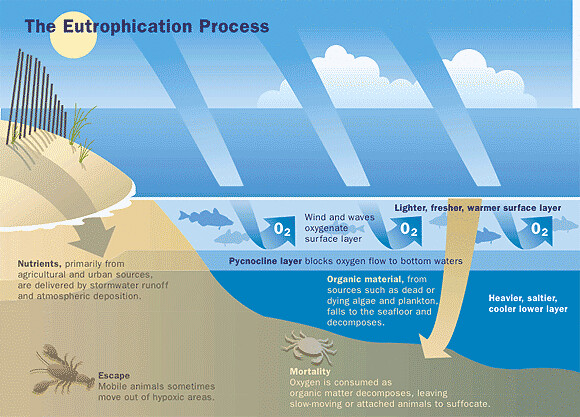
How does an algal bloom cause eutrophication of a water body? name a weed that grows in such a eutrophic lake?
Answer
576.3k+ views
Hint: Eutrophication is the enhancement of the biological productivity of water bodies due to the accumulation of nutrient elements under the action of human-induced or natural factors.
Complete answer:
Eutrophication is the natural aging process of the lake by nutrient enrichment of its water. During eutrophication, algal blooms release toxic chemicals that kill birds, fishes, and other aquatic animals causing the water to sink. The decomposition of algal blooms leads to oxygen depletion in the water. Thus with a high (CO), level, and poor oxygen supply, aquatic organisms begin to die and therefore the clean water turns into a stinking drain. So, When (O), the level falls to zero (anaerobic zone), some bacteria drive oxygen through the reduction of nitrates. When complete exhaustion of nitrate is completed, oxygen may as a final resort be obtained by reduction of sulfate yielding hydrogen sulfide causing the foul smell and putrefied taste of water. The characteristic feature of eutrophication is the excessive growth of aquatic and coastal plants (reed, typha, pond grass, waterweed).

The weed that grows in such a eutrophic lake is Eichhornia crassipes/water hyacinth.
From the moment of "birth," a water body passes several stages in its development firstly from ultra oligotrophic to oligotrophic and then to mesotrophic, and, finally, to eutrophic and hypereutrophic, i.e. aging and death to form a swamp. However, human activities impart specific features in this natural process. The rate and intensity of the productivity enhancement of ecosystems sharply increase.
Note: Due to over-fertilization algae and diatoms have a high degree of dominance. Algae and rooted weeds interfere with the clog the filters, hydroelectric power, retard the water flow, and affect water quality. Macrophytes, particularly Hydrilla, Myriophyllum, Potamogeton, and Ceratophyllum assume high population densities making nearshore and shallow regions unsuited for any further purpose.
Complete answer:
Eutrophication is the natural aging process of the lake by nutrient enrichment of its water. During eutrophication, algal blooms release toxic chemicals that kill birds, fishes, and other aquatic animals causing the water to sink. The decomposition of algal blooms leads to oxygen depletion in the water. Thus with a high (CO), level, and poor oxygen supply, aquatic organisms begin to die and therefore the clean water turns into a stinking drain. So, When (O), the level falls to zero (anaerobic zone), some bacteria drive oxygen through the reduction of nitrates. When complete exhaustion of nitrate is completed, oxygen may as a final resort be obtained by reduction of sulfate yielding hydrogen sulfide causing the foul smell and putrefied taste of water. The characteristic feature of eutrophication is the excessive growth of aquatic and coastal plants (reed, typha, pond grass, waterweed).

The weed that grows in such a eutrophic lake is Eichhornia crassipes/water hyacinth.
From the moment of "birth," a water body passes several stages in its development firstly from ultra oligotrophic to oligotrophic and then to mesotrophic, and, finally, to eutrophic and hypereutrophic, i.e. aging and death to form a swamp. However, human activities impart specific features in this natural process. The rate and intensity of the productivity enhancement of ecosystems sharply increase.
Note: Due to over-fertilization algae and diatoms have a high degree of dominance. Algae and rooted weeds interfere with the clog the filters, hydroelectric power, retard the water flow, and affect water quality. Macrophytes, particularly Hydrilla, Myriophyllum, Potamogeton, and Ceratophyllum assume high population densities making nearshore and shallow regions unsuited for any further purpose.
Recently Updated Pages
A man running at a speed 5 ms is viewed in the side class 12 physics CBSE

State and explain Hardy Weinbergs Principle class 12 biology CBSE

Which of the following statements is wrong a Amnion class 12 biology CBSE

Two Planoconcave lenses 1 and 2 of glass of refractive class 12 physics CBSE

The compound 2 methyl 2 butene on reaction with NaIO4 class 12 chemistry CBSE

Bacterial cell wall is made up of A Cellulose B Hemicellulose class 12 biology CBSE

Trending doubts
What are the major means of transport Explain each class 12 social science CBSE

Which are the Top 10 Largest Countries of the World?

Draw a labelled sketch of the human eye class 12 physics CBSE

Explain sex determination in humans with line diag class 12 biology CBSE

Give 10 examples of unisexual and bisexual flowers

State the principle of an ac generator and explain class 12 physics CBSE




